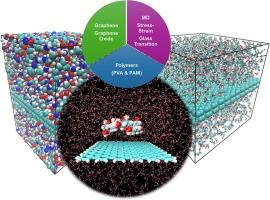Effects of graphene reinforcement on morphology, thermophysical, and mechanical properties of polyvinyl alcohol and polyacrylamide in condensed phases
IF 3
3区 化学
Q3 CHEMISTRY, PHYSICAL
引用次数: 0
Abstract
The subtle interplay of noncovalent interaction in enhancing the compatibility between the graphene-based material and the oligomers of polyvinyl alcohol (PVA) and polyacrylamide (PAM) in the solvent phase is unraveled within the framework of all-atom classical force field-based molecular dynamics (MD) simulations. The decomposition of binding free energy analysis demonstrates that the interaction between polymer segments and graphene (G)-surface crucially emanates from the van der Waals (vdW) interactions, while the adsorption of polymer chains on the graphene oxide (GO)-surface is influenced by vdW and electrostatic interactions. The influence of diverse factors including the strain rate, the size of the nanofiller, the number of oligomers, and the thermal quenching rate on controlling the morphology, mechanical, and thermophysical properties of the graphene-reinforced polymer nanocomposites are further explored. The uniaxial deformation simulations of the graphene-reinforced PVA and PAM matrices show that the interfacial mechanical strength is escalated for the G-PVA nanocomposite. The inclusion of graphene nanofiller reduces the polymer chain mobility and increases the intermolecular interaction, which in turn enhances the toughness of the graphene-polymer composites. Increasing the strain rate raises the yield strength and modulus, making the composites appear stronger and stiffer. As evidenced by the predicted glass transition temperature, the thermal stability of the PVA and PAM matrices is significantly improved by the graphene reinforcement.

石墨烯增强对凝聚相中聚乙烯醇和聚丙烯酰胺的形态、热物理和机械性能的影响
在基于经典力场的全原子分子动力学(MD)模拟框架内,揭示了非共价相互作用在增强石墨烯基材料与聚乙烯醇(PVA)和聚丙烯酰胺(PAM)低聚物在溶剂相中的相容性方面的微妙相互作用。结合自由能的分解分析表明,聚合物片段与石墨烯(G)表面之间的相互作用主要来自范德华(vdW)相互作用,而聚合物链在氧化石墨烯(GO)表面的吸附则受到 vdW 和静电相互作用的影响。研究还进一步探讨了应变速率、纳米填料尺寸、低聚物数量和热淬火速率等不同因素对控制石墨烯增强聚合物纳米复合材料的形态、机械和热物理性能的影响。石墨烯增强 PVA 和 PAM 基体的单轴变形模拟表明,G-PVA 纳米复合材料的界面机械强度得到了提高。石墨烯纳米填料的加入降低了聚合物链的流动性,增加了分子间的相互作用,从而提高了石墨烯-聚合物复合材料的韧性。增加应变速率可提高屈服强度和模量,使复合材料看起来更强更硬。从预测的玻璃化转变温度可以看出,石墨烯增强材料显著提高了 PVA 和 PAM 基质的热稳定性。
本文章由计算机程序翻译,如有差异,请以英文原文为准。
求助全文
约1分钟内获得全文
求助全文
来源期刊

Computational and Theoretical Chemistry
CHEMISTRY, PHYSICAL-
CiteScore
4.20
自引率
10.70%
发文量
331
审稿时长
31 days
期刊介绍:
Computational and Theoretical Chemistry publishes high quality, original reports of significance in computational and theoretical chemistry including those that deal with problems of structure, properties, energetics, weak interactions, reaction mechanisms, catalysis, and reaction rates involving atoms, molecules, clusters, surfaces, and bulk matter.
 求助内容:
求助内容: 应助结果提醒方式:
应助结果提醒方式:


